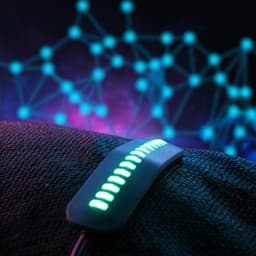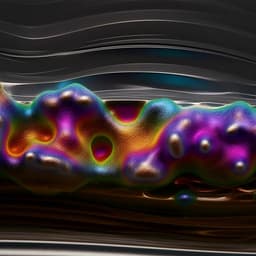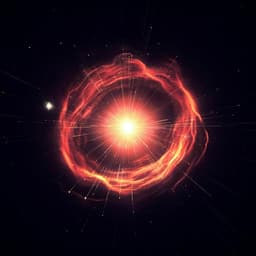
Physics
Ultrafast and persistent photoinduced phase transition at room temperature monitored by streaming powder diffraction
M. Hervé, G. Privault, et al.
Discover groundbreaking insights into ultrafast photoinduced phase transitions at room temperature, a study where materials' properties are manipulated with precision using a single laser shot. Conducted by renowned researchers including Marius Hervé and Gaël Privault, this research reveals how polarons transform the structure of Rb<sub>0.94</sub>Mn<sub>0.94</sub>Co<sub>0.06</sub>[Fe(CN)<sub>6</sub>]<sub>0.98</sub> in mere picoseconds, opening new pathways for studying non-reversible dynamics.
~3 min • Beginner • English
Introduction
The study addresses how to achieve on-demand, ultrafast and persistent control of material properties using light, fulfilling key criteria for photonic devices such as room-temperature operation, wide thermal bistability, single-shot threshold switching, and long-lived photoinduced states. Molecular materials undergoing photoinduced phase transitions (PIPT), particularly cyanide-bridged bimetallic Prussian blue analogues, offer reversible, multifunctional properties controllable by light. The authors investigate Rb0.94Mn0.94Co0.06[Fe(CN)6]0.98·0.2H2O, chemically tuned to exhibit a 75 K thermal hysteresis centered near room temperature between a MnIIIFeII tetragonal low-temperature phase and a MnIIFeIII cubic high-temperature phase. The research question is whether a single laser shot at room temperature can trigger an ultrafast, cooperative, and persistent tetragonal-to-cubic phase transition and how elastic interactions and charge-transfer polarons mediate this process. The work aims to elucidate the out-of-equilibrium structural dynamics and mechanism via time-resolved X-ray diffraction enabled by a streaming powder technique.
Literature Review
The paper situates itself within efforts to control quantum and molecular materials with light across ultrafast timescales, referencing prior demonstrations of photoinduced phase transitions, photomagnetism, spin-crossover switching, and polaron dynamics. Cyanide-bridged bimetallic assemblies (Prussian blue analogues) are highlighted for their intermetallic charge-transfer enabling multifunctionality (e.g., magnetism, ion conduction, optical responses) controllable by light. Earlier studies reported reversible photomagnetism in rubidium manganese hexacyanoferrate, ultrafast charge transfer and spin dynamics, and Landau-theory descriptions of coupled electronic and ferroelastic instabilities. However, direct, time-resolved monitoring of non-reversible, single-shot PIPT at room temperature with structural resolution remained limited, motivating the present approach combining streaming powder diffraction and TR-XRD.
Methodology
- Material synthesis and characterization: Rb0.94Co0.06Mn0.94[Fe(CN)6]0.98·0.2H2O synthesized as plate-shaped microcrystals (average size 0.9 ± 0.3 µm). Magnetic, XRD and IR measurements confirm a CT-driven phase transition with T_c (cooling) = 253 K and T_N (warming) = 328 K, yielding a 75 K thermal hysteresis centered at ~290.5 K. Room-temperature HT phase: cubic F43m, a_HT = 10.5495(6) Å; LT phase: tetragonal F42m, a_LT = b_LT = 10.0051(11) Å, c_LT = 10.4744(16) Å.
- Static photoinduced film tests: Films prepared by depositing ethanol suspension on glass. LT phase obtained by cooling to 180 K; HT by heating to >350 K. At room temperature, a 532 nm CW laser (100 mW, 0.5 × 0.45 mm² FWHM spot, 120 W cm−2, 3 s) induces a persistent colour change at the irradiated spots consistent with HT phase.
- Streaming powder diffraction setup (TR-XRD): Experiments at ESRF ID09. X-ray: 14.963–15 keV (λ≈0.824–0.827 Å), pulse duration ~35 ps (HWHM), spot 25 × 25 µm². Laser pump: 650 nm, 1 ps pulses, spot 210 × 250 µm², fluence 0–150 mJ cm−2, repetition 1 kHz. Penetration depth at 650 nm ~1.9 µm (larger than crystal size) for relatively homogeneous excitation. Crystals dispersed in ethanol (transparent at 650 nm) and streamed through a 300 µm free-flowing jet; crystal-solvent weight ratio 1:270 (~500 crystals per X-ray shot). Jet flow rate 1.2 L h−1 (velocity ~5 m s−1), ensuring a fresh ensemble for each pump-probe cycle; closed-loop circulation with a cooling device resets any photoconverted crystals to the LT ground state before re-injection.
- Data acquisition: Delays from −3 ns to +10 µs; typically 20 diffraction images per delay; integration time 5 s per image. Diffraction rings (randomly oriented microcrystals) azimuthally integrated using pyFAI. Images normalized over Q-range [5.5, 6.0] Å−1.
- Data processing and structural refinement: Solvent background subtracted (pure ethanol pattern, then polynomial residual correction). Rietveld refinements performed with TOPAS-Academic v6 at fixed wavelength 0.827389 Å (15 keV). Equilibrium refinements over Q=[0.9, 5.0] Å−1 using F42m (LT) and F43m (HT). Time-resolved patterns modeled with two time-dependent phases: photoexcited tetragonal (PT) and photoinduced cubic (PIC), refining lattice parameters, Debye–Waller factors, phase fractions (χ_PT, χ_PIC), and selected bond lengths. Streaming setup equilibrium lattice parameters: HT a_HT = 10.544(2) Å; LT a_LT = 10.023(2) Å, c_LT = 10.461(2) Å.
Key Findings
- Wide thermal hysteresis and structural contrast: The material exhibits a 75 K hysteresis between MnIIIFeII tetragonal LT (F42m) and MnIIFeIII cubic HT (F43m) phases; at room temperature both states are stable depending on history. LT unit cell (V_LT ≈ 1055 ų) contracts relative to HT.
- Low fluence dynamics (e.g., 15 mJ cm−2): Within ~100 ps, the PT lattice shows reverse Jahn–Teller reorganization (a_PT elongation, c_PT contraction), accompanied by a net volume expansion (~1 ų) due to long-lived photoinduced CT polarons. The tetragonal distortion parameter η decreases, and a small PIC fraction forms (χ_PIC ≈ 10%). The PT lattice relaxes back to equilibrium within ~10 µs as polarons decay; PIC fraction remains.
- Intermediate fluence (36 mJ cm−2): Mixed response with notable intensity shifts and emergence of PIC peaks; Rietveld refinements indicate ~50% conversion to PIC within ~100 ps. The remaining tetragonal fraction experiences larger reverse JT distortion than at low fluence, then relaxes within ~10 µs, while the PIC fraction persists.
- High fluence (115 mJ cm−2): Near-complete conversion from LT to PIC within 75–100 ps. The PT Bragg peaks nearly vanish, and PIC peaks dominate, marked by merging of (h00) and (00h) reflections. χ_PIC approaches ~100%, limited by excitation coverage in the jet.
- Structural metrics of PIC: V_PIC increases from 1096(5) ų within the time resolution to 1167(2) ų after full conversion, matching the thermodynamic HT phase volume. The PIC crystalline structure at 1 ns (36 mJ cm−2) is consistent with the MnIIFeIII HT phase.
- Threshold and kinetics: Fluence-dependent conversion χ_PIC(t) at 100 ps–500 ns reveals a threshold near ~10 mJ cm−2 for establishing the PIC phase within <1 ns. Conversion saturates (nearly complete) above ~100 mJ cm−2. A weaker, secondary conversion step around ~10 ns is observed at intermediate fluences, attributed to slower heat diffusion.
- Mechanistic insights: The ~100 ps timescale matches the crystal radius divided by the longitudinal sound speed (~450 nm / 4300 m s−1), indicating an elastically driven process. Below threshold, CT polarons cause anisotropic local distortions (Mn–N_xy elongation, Mn–N_z contraction) and macroscopic lattice expansion without symmetry change. Above threshold, cooperative elastic interactions and volume expansion destabilize the tetragonal lattice, enabling rapid nucleation and growth of the cubic phase.
- Landau framework: A Landau potential including the CT order parameter q, the symmetry-breaking ferroelastic parameter η, and their coupling to volume strain v accounts for the threshold behavior and persistence: photoinduced volume expansion raises the elastic cost Δv·η², reducing η and, beyond a critical Δv, driving the system over the barrier into η=0 (cubic). The energy barrier then stabilizes the photoinduced cubic phase at room temperature.
Discussion
The findings demonstrate that a single laser pulse can trigger an ultrafast, cooperative, and persistent tetragonal-to-cubic phase transition at room temperature within a wide thermal hysteresis. Time-resolved diffraction resolves the out-of-equilibrium pathway: below threshold fluence, photoinduced CT polarons drive reverse Jahn–Teller distortions and volumetric expansion while maintaining tetragonal symmetry; above threshold, the accumulated elastic strain and volume expansion nucleate the cubic phase that matches the equilibrium HT structure and remains persistent due to an energy barrier. The ~100 ps transformation time aligns with elastic propagation across the microcrystals, emphasizing elastically mediated cooperativity. The non-linear fluence dependence and nucleation behavior substantiate a cooperative PIPT mechanism, with a minor delayed component (~10 ns) reflecting thermal diffusion. A Landau description coupling q and η to the volume strain v captures the threshold switching and the persistence, reconciling microscale polaron formation with macroscale symmetry breaking and lattice expansion.
Conclusion
The study establishes that Rb0.94Mn0.94Co0.06[Fe(CN)6]0.98 exhibits single-shot, ultrafast (<100 ps) and persistent photoinduced tetragonal-to-cubic phase transition at room temperature within a 75 K hysteresis. A streaming powder TR-XRD technique enables direct monitoring of both microscopic (Mn–N bonds) and macroscopic (lattice parameters, symmetry) dynamics in a non-reversible transformation. The mechanism is driven by photoinduced CT polarons that expand the lattice and, above a threshold fluence (~10 mJ cm−2), collectively destabilize the tetragonal phase through elastic cooperativity to yield the cubic phase that persists due to an energy barrier in the Landau potential. The approach and insights have broad implications for optically driven devices, memories, and actuators requiring fast, thresholded, room-temperature switching. Future work can exploit XFEL implementations for femtosecond structural mapping and extend the streaming powder methodology to other functional materials exhibiting non-reversible ultrafast phenomena.
Limitations
- Temporal resolution: The TR-XRD experiment has ~35 ps time resolution, insufficient to directly resolve the sub-ps (≈200 fs) primary charge-transfer event; early-time electronic dynamics are inferred from prior spectroscopic studies.
- Observation window: The streaming jet flow (1.2 L h−1; ~5 m s−1) limits pump–probe delays to ≤10 µs, precluding direct tracking of longer-term relaxation processes beyond this window.
- Excitation homogeneity and coverage: In the liquid jet, only a fraction of crystals is fully illuminated at the requisite fluence per shot; incomplete excitation likely accounts for small residual tetragonal fractions at high fluence.
- Photon absorption quantification: The exact number of absorbed photons per crystal is not precisely determined; estimates of excited fraction rely on assuming near-unity quantum efficiency and linearity of volume change with CT fraction.
- Minor HT contribution in equilibrium data: Occasional weak HT-phase presence in equilibrium patterns requires careful background and phase-fraction handling in refinements.
Related Publications
Explore these studies to deepen your understanding of the subject.







